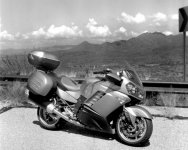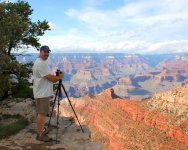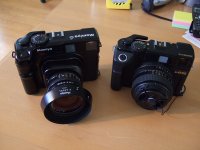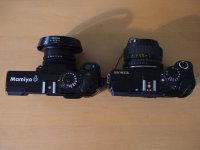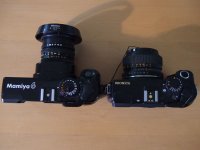Turtle
Veteran
As an owner of both the Mamiya 7 II and Bronica RF645, I thought I would write a summary piece on both cameras. After owning the Mamiya 7 for about 7 weeks and using the RF645 over about 3 years, it has become very clear that the two are very different cameras. This is a relief, as I bought the Mamiya 7 for very specific reasons, which I will comment on later. These are my views based on using the two cameras to conduct travel, street and scenic photography.
Controls/Ergonomics: I find the controls of the Bronica fall slightly better to my hands, but realise this is a personal view. This was obvious from the first time I picked them both up, the RF645 feeling as if I had used it for years within minutes. The Mamiya feels fine, but the swollen area around the lens mount is a bit too close to the grip meaning my fingers get kinda wedged in this gap and that feels a touch unnatural to me. The exposure compensation lever on the RF645 is far quicker to use. With the M7 it is fiddlier and less intuitive (and also feels less than positive at times). Some complain that the RF645 lever is easily knocked, but mine are relatively stiff and do not get moved by accident - perhaps there is sample variation here, just like with aperture rings! This RF645 lever can be moved more easily with the camere gripped in the right hand, whereas the M7 is more of a fiddly experience. Still, the M7 seems to produce good exposures (monochrome) despite the very small area covered by the meter. I am used to using a spot meter for LF and so pretty instinctively hone in on the values I am interested in. The meter is not bad, just simple (see later). I also find the film speed setting dial cleaner and more obvious on the RF645. You press a release button and then turn the dedicated dial - It is also easier to see at a glance. With the M7 you have to mess about with the shutter dial surround which is already involved with shutter speed and compensation. To me, this is a far messier solution to a simple problem.
Viewfinders: The viewfinders on both are excellent. Both are bright enough and with sufficient contrast. I prefer that of the M7 for angle of view as I can use the 65 with frame lines. With the Rf645, I can use the 65 (narrower angle of view on the smaller neg of course) but the 45 needs the accessory finder. I prefer the shutter speed display etc of the RF645, which I feel is easier to see. The M7 display and over/under exposure indicators seem crude in comparison and for me were easier to miss when, for example, the aperture selected in AE mode requires a shutter speed greater than 1/500th max. The Bronica also shows more by way of partial stops. The RF645 finder is vertical, but this is not an issue for me when using the camera alone. As I began to use a Leica M more and more I found I wanted the same orientation as I would be carrying both together a lot of the time (Leica out and ready, MF RF in bag). In this regard the Mamiya 7’s horizontal finder is preferable. When used alone it takes all of 3 seconds to readjust to the RF645 vertical finder.
Metering: The RF645 has a more area based system and is very accurate in my view (I know some disagree here). I have not once had had wayward exposures with mine, but then again I don’t use slide film much. The M7 metering seems concentrated pretty well smack where my rangefinder patch is and more akin to a partial spot. Seems accurate enough for mono as long as I make sure I am not pointing that spot towards anything too bright. In this regard it can be used to take more localised readings and build up more of an idea of brightness range etc. However, for speed, the more comprehensive metering on the RF645 is arguably better. It seems to be more centre weighted or averaged than the Mamiya. I also dislike the fact that the Mamiya 7 wides only have full stops, no half stop detents. This is frankly shameful as combined with the metering it denies you vital information and control. It might be the case that in AE or AEL the shutter still fires in partial steps (I am not sure, but recall hearing that it does) but the perceived loss of control (along with relatively spartan viewfinder info) is not comforting. I shot some snap portraits with trannie film (first time in years) a few days back and I felt I had no idea what was really going on with the meter readings showing as blinking and static whole stop readings.
Optical performance/Neg Quality: The optics on both are superb (I own the 65 and 45 for the RF645 and 50, 65, 80, 150 on the M7). With the RF645, the 65 and 45 both perform flawlessly producing great resolution and ample contrast from wide open. At a stop or two down they are blinding. The M7 does similarly, although with more contrast and in my reluctant opinion a little more resolution. I printed my friends M7 negs years ago and was hugely impressed, but looking at shots on a light box with a 8X lupe I am simply staggered. Corner resolution suffers a little wide open on the 65mm but on centre is mind boggling. I am tempted to test these optics against my Leica/Zeiss lenses because I am very confident that these Mamiya optics will hold their own even when comparing a 35mm section from the 6x7 neg. The 50 and 80 are similarly sharp, although I have found the 65 to my perfect standard lens for scenic/travel type walking about. I have tested my 150mm on near and far objects and am pleased to discover that the focus is smack on; it is also incredibly sharp. It is not always easy to get accurate focus on distant subjects (that are just short of the cameras infinity) wide open. One has to be careful to use the focus setting indicated by the rangefinder rather than just assume the subject is at infinity. I can tell you that a subject of about 1km is not infinity and needs to be focused just shy of infinity. 2-3km is more like infinity as far as this set up goes. When shooting at something far away, such as a mountain line 2+ miles away, focusing at infinity is important as the converse became true. Great care is required to get this right as the subject details are often very small. I doubt that anything issues would be visible at f8+ however, even if less than total care was applied. No doubt about it though, care is required at F4.5. Closer subjects were in sharp focus without too much trouble however as it was easier to see the focus error when not correctly focused – subjects were bigger and this made focus easier.
‘Useability’
The M7 is Bigger. It is longer from nose to tail and feels it. Lens changes are far slower by virtue of the manual light curtain having to be closed and then opened. The rear sections of the lenses are sometimes tricky to navigate home without catching it on delicate rangefinder coupling etc. Not a problem when you have neatly laid your kit bag down on a grassy hill in the UK, but a pain in the ass when you are juggling lenses and filters in a dusty environment like Afghanistan. I also find changing film far faster with the RF645. I just find it harder to pick out the spools on the Mamiya 7. This is noticeable. The Mamiya sometimes wont advance in partial strokes when advancing newly loaded new film to the start line. This is a pig as winding the lever all the way when balancing the open camera on knees/belly bag etc is not always easy. As I found out yesterday, when shooting some portraits and scenic shots in Kabul, these ‘little things’ do add up, making the RF645 a LOT faster to use when considering the complete cycle: Film loading, removal, exposure compensation, metering, filter changes (exposure compensation again), more frequent film reloading required (10 vs 16 frames), light curtain winding and release etc. This is not as a result of familiarity, but due to the RF645 having a lot of small kinks ironed out making for fewer interruptions and less concentration required not to get snagged up.
Both produce stunning negs, but in addition to the larger neg, my lupe may be showing me slightly more resolution from the M7. Its rather unimportant, however, as both are incredibly sharp, full stop and from wide open. The M7 lenses produce slightly more contrast which may or may not be to your taste, but resolution is absolutely staggering. In the kit bag, the RF645 lenses take up much less space, which might also be a consideration. They are also lighter.
The shutter noise is extremely low on the Mamiya 7 and very low on the Bronica. The RF645 has a weird ‘sneeze/meow’ as the shutter fires and re-cocks. Although unusual, I quite like this strangely relaxing sound! It is very quiet overall and probably still quieter than a Leica M. The feel is very different on both. The RF645 has a cleaner and slightly stiffer break, but the M7 is wonderfully light for those low shutter speed shots when you need to squeeze out the last drop of stability. Both offer great predictability, but I would argue that with very cold hands or when involved in ‘action’ the M7 might prove too light. The RF645 release cannot be faulted in my view. Its amongst the best I have experienced.
Build Quality: The RF645 feels much more solidly built than the Mamiya in my view, although this is not to say that this is the case in use. The twist lever for closing the light shield on the M7 is decidedly flimsy, but this may be deliberate and in order to prevent cracking under load. The shell of the Bronica feels less ‘plasticky’, although the rear control panel is more akin to the Mamiya 7 feel. Both have equally well constructed lenses and similarly smooth, well damped focus throws. In the hand, however, the Bronnie just feels more solid to me and although that has limited practical value, it is nevertheless quite noticeable and satisfying.
Conclusion: Choosing between these two camera does not simply come down to format choices. I wont waffle on about system availability etc, but utility instead. In my view, the RF645 is a far more accomplished camera overall. From what I have read, I thought this might be the case and bought the Mamiya 7II because I wanted the biggest neg I could get to compliment carrying my Leica M. The RF645 is somewhere in between when it comes to speed and ease of handling, but arguably closer to the Leica than the Mamiya. I wanted the Mamiya for the best quality 400 speed film handheld and the best quality prints from 100 or below on a tripod. This it delivers very nicely. However, as the pace picks up, cameras come on and off tripods (with an ordinary QR adaptor film cannot be changed on the Mamiya 7 as the little spool release lugs cannot pop out), lenses and filters, films etc are changed the Mamiya finds itself outclassed in every respect by the RF645. Would I recommend the Mamiya 7 as your only walk about camera? No. The RF645 whips it in terms of speed and ergonomics in my view. However, the limited lens range is an issue and was one of the reasons I went for the Mamiya 7. I found myself wanting wider than 45mm on 645 and a short tele. The RF645 does not offer anything wider than 45mm and getting a 100 or 135 is like tracking down a unicorn. Where the Mamiya scores for me is also in the 65mm frame lines. This allows me to walk about with one single lens that I would use for 75% of shots. With the RF645 I use the 65 and 45 about 60-40 and so there is more swapping. It is a heck of a lot quicker to do so though.
In summary, the RF645 is the camera I would walk about with if I wanted to keep things simple at the same time as having the larger neg. In other words it is a good replacement for a Leica M under circumstances where you might want the larger real estate and will be shooting in the 35mm equiv range of 28-43mm. It is therefore fine for street work where I personally rarely use anything longer than std. The Mamiya 7 is the better camera for when you want maximum system flexibility (lenses) and ultimate print quality, but head to head with the RF645 in a ‘walkabout scenario’ it is a far less ‘useable’ camera in my view. The result of this is that I might end up keeping my RF645 with 65 and 45 and selling one body with 65. This will allow the best of both words. I would, however, say this: anyone with a RF645 and thinking of trading up to a Mamiya 7 for street/walkabout work, think again. You might find yourself hugely disappointed. For those doing ‘posh travel’ where shots are more ‘scenic’ slower paced or where their work is under more controlled circumstances, the Mamiya 7II’s deficiencies will be less of a nuisance and you will be able to enjoy those whopping negs to the full.
As I say, these are my view and not gospel. Your experiences might vary! I have however used both under difficult circumstances and the differences became fairly glaring! Both wonderful, but different. Having just picked up my RF645 after not being used in several months, I am reminded of just how good its handling really is.
Controls/Ergonomics: I find the controls of the Bronica fall slightly better to my hands, but realise this is a personal view. This was obvious from the first time I picked them both up, the RF645 feeling as if I had used it for years within minutes. The Mamiya feels fine, but the swollen area around the lens mount is a bit too close to the grip meaning my fingers get kinda wedged in this gap and that feels a touch unnatural to me. The exposure compensation lever on the RF645 is far quicker to use. With the M7 it is fiddlier and less intuitive (and also feels less than positive at times). Some complain that the RF645 lever is easily knocked, but mine are relatively stiff and do not get moved by accident - perhaps there is sample variation here, just like with aperture rings! This RF645 lever can be moved more easily with the camere gripped in the right hand, whereas the M7 is more of a fiddly experience. Still, the M7 seems to produce good exposures (monochrome) despite the very small area covered by the meter. I am used to using a spot meter for LF and so pretty instinctively hone in on the values I am interested in. The meter is not bad, just simple (see later). I also find the film speed setting dial cleaner and more obvious on the RF645. You press a release button and then turn the dedicated dial - It is also easier to see at a glance. With the M7 you have to mess about with the shutter dial surround which is already involved with shutter speed and compensation. To me, this is a far messier solution to a simple problem.
Viewfinders: The viewfinders on both are excellent. Both are bright enough and with sufficient contrast. I prefer that of the M7 for angle of view as I can use the 65 with frame lines. With the Rf645, I can use the 65 (narrower angle of view on the smaller neg of course) but the 45 needs the accessory finder. I prefer the shutter speed display etc of the RF645, which I feel is easier to see. The M7 display and over/under exposure indicators seem crude in comparison and for me were easier to miss when, for example, the aperture selected in AE mode requires a shutter speed greater than 1/500th max. The Bronica also shows more by way of partial stops. The RF645 finder is vertical, but this is not an issue for me when using the camera alone. As I began to use a Leica M more and more I found I wanted the same orientation as I would be carrying both together a lot of the time (Leica out and ready, MF RF in bag). In this regard the Mamiya 7’s horizontal finder is preferable. When used alone it takes all of 3 seconds to readjust to the RF645 vertical finder.
Metering: The RF645 has a more area based system and is very accurate in my view (I know some disagree here). I have not once had had wayward exposures with mine, but then again I don’t use slide film much. The M7 metering seems concentrated pretty well smack where my rangefinder patch is and more akin to a partial spot. Seems accurate enough for mono as long as I make sure I am not pointing that spot towards anything too bright. In this regard it can be used to take more localised readings and build up more of an idea of brightness range etc. However, for speed, the more comprehensive metering on the RF645 is arguably better. It seems to be more centre weighted or averaged than the Mamiya. I also dislike the fact that the Mamiya 7 wides only have full stops, no half stop detents. This is frankly shameful as combined with the metering it denies you vital information and control. It might be the case that in AE or AEL the shutter still fires in partial steps (I am not sure, but recall hearing that it does) but the perceived loss of control (along with relatively spartan viewfinder info) is not comforting. I shot some snap portraits with trannie film (first time in years) a few days back and I felt I had no idea what was really going on with the meter readings showing as blinking and static whole stop readings.
Optical performance/Neg Quality: The optics on both are superb (I own the 65 and 45 for the RF645 and 50, 65, 80, 150 on the M7). With the RF645, the 65 and 45 both perform flawlessly producing great resolution and ample contrast from wide open. At a stop or two down they are blinding. The M7 does similarly, although with more contrast and in my reluctant opinion a little more resolution. I printed my friends M7 negs years ago and was hugely impressed, but looking at shots on a light box with a 8X lupe I am simply staggered. Corner resolution suffers a little wide open on the 65mm but on centre is mind boggling. I am tempted to test these optics against my Leica/Zeiss lenses because I am very confident that these Mamiya optics will hold their own even when comparing a 35mm section from the 6x7 neg. The 50 and 80 are similarly sharp, although I have found the 65 to my perfect standard lens for scenic/travel type walking about. I have tested my 150mm on near and far objects and am pleased to discover that the focus is smack on; it is also incredibly sharp. It is not always easy to get accurate focus on distant subjects (that are just short of the cameras infinity) wide open. One has to be careful to use the focus setting indicated by the rangefinder rather than just assume the subject is at infinity. I can tell you that a subject of about 1km is not infinity and needs to be focused just shy of infinity. 2-3km is more like infinity as far as this set up goes. When shooting at something far away, such as a mountain line 2+ miles away, focusing at infinity is important as the converse became true. Great care is required to get this right as the subject details are often very small. I doubt that anything issues would be visible at f8+ however, even if less than total care was applied. No doubt about it though, care is required at F4.5. Closer subjects were in sharp focus without too much trouble however as it was easier to see the focus error when not correctly focused – subjects were bigger and this made focus easier.
‘Useability’
The M7 is Bigger. It is longer from nose to tail and feels it. Lens changes are far slower by virtue of the manual light curtain having to be closed and then opened. The rear sections of the lenses are sometimes tricky to navigate home without catching it on delicate rangefinder coupling etc. Not a problem when you have neatly laid your kit bag down on a grassy hill in the UK, but a pain in the ass when you are juggling lenses and filters in a dusty environment like Afghanistan. I also find changing film far faster with the RF645. I just find it harder to pick out the spools on the Mamiya 7. This is noticeable. The Mamiya sometimes wont advance in partial strokes when advancing newly loaded new film to the start line. This is a pig as winding the lever all the way when balancing the open camera on knees/belly bag etc is not always easy. As I found out yesterday, when shooting some portraits and scenic shots in Kabul, these ‘little things’ do add up, making the RF645 a LOT faster to use when considering the complete cycle: Film loading, removal, exposure compensation, metering, filter changes (exposure compensation again), more frequent film reloading required (10 vs 16 frames), light curtain winding and release etc. This is not as a result of familiarity, but due to the RF645 having a lot of small kinks ironed out making for fewer interruptions and less concentration required not to get snagged up.
Both produce stunning negs, but in addition to the larger neg, my lupe may be showing me slightly more resolution from the M7. Its rather unimportant, however, as both are incredibly sharp, full stop and from wide open. The M7 lenses produce slightly more contrast which may or may not be to your taste, but resolution is absolutely staggering. In the kit bag, the RF645 lenses take up much less space, which might also be a consideration. They are also lighter.
The shutter noise is extremely low on the Mamiya 7 and very low on the Bronica. The RF645 has a weird ‘sneeze/meow’ as the shutter fires and re-cocks. Although unusual, I quite like this strangely relaxing sound! It is very quiet overall and probably still quieter than a Leica M. The feel is very different on both. The RF645 has a cleaner and slightly stiffer break, but the M7 is wonderfully light for those low shutter speed shots when you need to squeeze out the last drop of stability. Both offer great predictability, but I would argue that with very cold hands or when involved in ‘action’ the M7 might prove too light. The RF645 release cannot be faulted in my view. Its amongst the best I have experienced.
Build Quality: The RF645 feels much more solidly built than the Mamiya in my view, although this is not to say that this is the case in use. The twist lever for closing the light shield on the M7 is decidedly flimsy, but this may be deliberate and in order to prevent cracking under load. The shell of the Bronica feels less ‘plasticky’, although the rear control panel is more akin to the Mamiya 7 feel. Both have equally well constructed lenses and similarly smooth, well damped focus throws. In the hand, however, the Bronnie just feels more solid to me and although that has limited practical value, it is nevertheless quite noticeable and satisfying.
Conclusion: Choosing between these two camera does not simply come down to format choices. I wont waffle on about system availability etc, but utility instead. In my view, the RF645 is a far more accomplished camera overall. From what I have read, I thought this might be the case and bought the Mamiya 7II because I wanted the biggest neg I could get to compliment carrying my Leica M. The RF645 is somewhere in between when it comes to speed and ease of handling, but arguably closer to the Leica than the Mamiya. I wanted the Mamiya for the best quality 400 speed film handheld and the best quality prints from 100 or below on a tripod. This it delivers very nicely. However, as the pace picks up, cameras come on and off tripods (with an ordinary QR adaptor film cannot be changed on the Mamiya 7 as the little spool release lugs cannot pop out), lenses and filters, films etc are changed the Mamiya finds itself outclassed in every respect by the RF645. Would I recommend the Mamiya 7 as your only walk about camera? No. The RF645 whips it in terms of speed and ergonomics in my view. However, the limited lens range is an issue and was one of the reasons I went for the Mamiya 7. I found myself wanting wider than 45mm on 645 and a short tele. The RF645 does not offer anything wider than 45mm and getting a 100 or 135 is like tracking down a unicorn. Where the Mamiya scores for me is also in the 65mm frame lines. This allows me to walk about with one single lens that I would use for 75% of shots. With the RF645 I use the 65 and 45 about 60-40 and so there is more swapping. It is a heck of a lot quicker to do so though.
In summary, the RF645 is the camera I would walk about with if I wanted to keep things simple at the same time as having the larger neg. In other words it is a good replacement for a Leica M under circumstances where you might want the larger real estate and will be shooting in the 35mm equiv range of 28-43mm. It is therefore fine for street work where I personally rarely use anything longer than std. The Mamiya 7 is the better camera for when you want maximum system flexibility (lenses) and ultimate print quality, but head to head with the RF645 in a ‘walkabout scenario’ it is a far less ‘useable’ camera in my view. The result of this is that I might end up keeping my RF645 with 65 and 45 and selling one body with 65. This will allow the best of both words. I would, however, say this: anyone with a RF645 and thinking of trading up to a Mamiya 7 for street/walkabout work, think again. You might find yourself hugely disappointed. For those doing ‘posh travel’ where shots are more ‘scenic’ slower paced or where their work is under more controlled circumstances, the Mamiya 7II’s deficiencies will be less of a nuisance and you will be able to enjoy those whopping negs to the full.
As I say, these are my view and not gospel. Your experiences might vary! I have however used both under difficult circumstances and the differences became fairly glaring! Both wonderful, but different. Having just picked up my RF645 after not being used in several months, I am reminded of just how good its handling really is.
Last edited:


